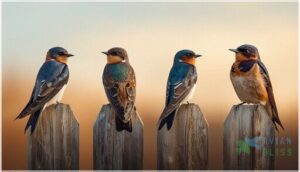This site is supported by our readers. We may earn a commission, at no cost to you, if you purchase through links.
You’ll spot a cliff swallow long before you notice its name—a metallic flash of dark blue banking low over water, chasing insects with the kind of precision that makes you forget to blink. These birds carry their signature in the rusty cheek patches that frame a white forehead, a color combination as distinctive as a fingerprint.
Measuring just 12–14 cm from beak to squared tail, they punch well above their weight class in ecological importance. Their mud architecture dots bridges and canyon walls from Alaska to Argentina, proving that size means nothing when you’ve mastered the art of aerial hunting and communal living.
What makes them thrive where other species falter comes down to adaptation, cooperation, and an insatiable appetite for the insects most of us would rather not think about.
Table Of Contents
- Key Takeaways
- Cliff Swallow Identification
- Habitat and Geographic Range
- Nesting and Breeding Behavior
- Feeding Habits and Diet
- Conservation and Ecological Importance
- Frequently Asked Questions (FAQs)
- Where do cliff swallows nest?
- What is a cliff swallow?
- Are cliff swallows social?
- How much does a cliff swallow weigh?
- Where do cliff swallows live?
- What is the cliff swallow project?
- What is a Cliff Swallow?
- What’s the difference between a barn swallow and a Cliff Swallow?
- Why are cliff swallows protected?
- Are cliff swallows rare?
- Conclusion
Key Takeaways
- Cliff swallows thrive through colonial living and architectural ingenuity—building mud nests in clusters of hundreds on cliffs and bridges, where cooperation amplifies both predator defense and foraging efficiency across their massive range from Alaska to Argentina.
- These compact aerial hunters (12-14 cm, 18-24 grams) punch above their weight in pest control, with each bird consuming 1-2 grams of flying insects daily and colonies reducing local insect populations by up to 30% during breeding season.
- Their success hinges on phenotypic plasticity—adapting to both wild cliff faces and urban infrastructure while maintaining synchronized breeding cycles that align fledging with peak insect abundance, though urban nests show 6% lower fledging success than natural sites.
- Conservation challenges mount from habitat fragmentation, pesticide-driven prey declines of 20-30%, and climate-induced phenological mismatches that shift breeding cycles 4-6 days earlier annually, requiring international corridor protection across their transcontinental migration routes.
Cliff Swallow Identification
You can spot a Cliff Swallow by learning a few reliable field marks that set it apart from the crowd. These birds carry a striking combination of colors and structural details that make identification surprisingly straightforward once you know what to look for.
Let’s break down the key features that’ll help you confidently ID this species in the field.
Physical Description and Size
You’ll spot a Cliff Swallow by its compact body shape and broad, pointed wings—adults measure 12–14 cm with wingspans of 24–28 cm. Watch for metallic dark-blue backs that catch the light, pale cinnamon rumps, and rusty cheeks framing a white forehead. Their squared tail length and short beak size make them agile aerial hunters, weighing just 12–19 grams.
Understanding the importance of literature reviews can help in studying bird species.
Distinctive Coloration and Markings
Beyond size, you’ll recognize Cliff Swallows by their striking color patterns: metallic dark-blue backs show iridescence effects in sunlight, contrasting sharply with pale cinnamon rumps—a field mark that sets them apart from Purple Martins. Notice the rusty cheeks framing that distinctive white forehead, while the squared tail and compact beak shape complete their profile.
Plumage variation remains minimal, though feather texture appears sleek during the breeding season.
Comparison to Similar Swallow Species
When you’re sorting Cliff Swallows from lookalikes, focus on these key differences:
- Bank Swallow shows a uniform pale mantle and deeper tail fork—plus a smaller bill that’s hard to miss in flight
- Barn Swallows flash glossy blue-green backs and rufous throats, creating head patterns distinct from your subject’s white forehead
- Purple Martin colonies display brick-red adult coloration and different roosting dynamics altogether
Species differentiation hinges on tail shape, vocalizations, and colony dynamics during swallow migration.
Habitat and Geographic Range
Cliff Swallows aren’t picky about where they call home, as long as there’s open space for catching insects and vertical surfaces for building their mud nests. You’ll find them across a massive geographic range, from the cliffs of Alaska down to northern Argentina, following ancient migration routes that span two continents.
Their ability to thrive in both wild landscapes and human-altered environments has shaped their distribution in surprising ways.
Preferred Environments and Landscapes
You’ll find Cliff Swallows wherever vertical structures meet open foraging grounds—whether natural cliff faces or urban landscapes like bridges and buildings. They seek nesting sites with protective overhangs near water, where insect abundance peaks during breeding season. Here’s how their preferred habitat breaks down:
| Habitat Type | Key Features | Nesting Advantage |
|---|---|---|
| Cliffs | Vertical faces, natural overhangs | Weather protection, predator defense |
| Urban Landscapes | Bridges, culverts, barns | Sheltered microhabitats, warm microclimates |
| Coasts and Shorelines | Water proximity, insect density | High prey availability |
| Fields, Meadows, Grasslands | Open foraging areas | Abundant flying insects |
| Man-made Structures | Consistent ledges, crevices | Colony formation support |
These adaptable birds don’t just survive—they thrive by exploiting both wild cliffs and human-built alternatives. Understanding AP study resources can help us appreciate the importance of adaptive learning in various species.
Global Distribution and Migration Routes
You’re tracking a species that spans continents—Cliff Swallows breed from Alaska to northern Argentina, weaving through multiple flyways during seasonal movements. Their migration patterns reveal striking habitat connectivity:
- Peak southbound migration occurs August through October across hemispheres
- Migration distances exceed 5,000 kilometers for many populations
- Geographic range extends throughout North America to Central and South America
- Avian migration patterns follow regional flyway routes rather than single corridors
Understanding these species distribution dynamics helps you appreciate their conservation needs across international boundaries.
Adaptation to Urban and Natural Areas
You’ll notice striking adaptive behavior as Cliff Swallows navigate habitat fragmentation in urban planning landscapes. Their nesting habits show ecological resilience—colonies on bridges increased 32% recently, though fledging success drops to 68% versus 74% in natural sites.
This phenotypic plasticity demonstrates environmental sustainability challenges in avian ecology, where wildlife conservation and habitat conservation strategies must address migration and habitat needs across fragmented territories.
Nesting and Breeding Behavior
Cliff swallows break the mold regarding nesting—they’re fiercely social, building their mud homes side by side in colonies that can number in the hundreds. Their breeding strategy hinges on finding the right overhangs and gathering the right materials, all while coordinating egg-laying and chick-rearing in tight quarters.
Here’s what makes their nesting behavior so distinctive.
Colonial Nesting Habits
You’ll find cliff swallows thriving in dense colonies that can house hundreds of nests pressed side by side—a demonstration of their deeply social nesting habits. These colonial nesters rely on strength in numbers, creating bustling communities that offer protection and shared vigilance.
Why colonial nesting matters:
- Safety in numbers – Predators face overwhelming mob defenses
- Information exchange – Neighbors share foraging hotspots rapidly
- Synchronized breeding – Timing aligns fledging with peak insect abundance
- Territorial efficiency – Dense clusters optimize limited cliff space
Nest Construction and Site Selection
You’ll watch cliff swallows transform mud pellets—each weighing just 1–2 grams—into architectural marvels attached to vertical surfaces. They prefer sheltered alcoves on cliffs, bridges, or culverts near water and abundant flying insects. Nest architecture features a central cup wrapped in a mud envelope for insulation, with outward-facing openings that deter predators while optimizing flight access.
| Site Criteria | Mud Composition | Colony Formation |
|---|---|---|
| Overhanging cliffs with wind protection | Fine to medium granulometry for cohesion | Progressive establishment in late spring |
| Brick or concrete ledges on structures | Ideal durability under varying humidity | Central nests form first in colonies |
| Proximity to water and insect sources | Enhanced nest stability and heat exchange | Sizes range from few to hundreds |
| Low disturbance from noise or activity | Mud pellets gathered from nearby sources | Shared construction boosts success rates |
Clutch Size and Parental Roles
You’ll find cliff swallows lay 3–6 eggs per clutch, averaging 4–5 depending on insect availability. Both parents share incubation duties—females dominate early shifts, males contribute during cooler hours.
After hatching, biparental feeding intensifies, with synchronized bouts supporting nestling growth through the 21–26 day fledging period. This breeding success hinges on cooperation, as helpers rarely assist in these colonial bird species.
Feeding Habits and Diet
Cliff Swallows live and breathe for one thing: catching insects on the wing. You’ll see them carving through open air with precision, snatching flies, beetles, and bugs mid-flight in a feeding strategy that’s both elegant and efficient.
Let’s break down what powers their aerial hunt, where they find their best meals, and how colony life shapes the way they feed.
Insectivorous Diet and Foraging Techniques
You’ll see cliff swallows performing exceptional aerial hunting, capturing flying insects mid-flight with agile, rapid wing beats. Their insectivorous diet centers on dipterans—true flies—plus beetles, bees, and wasps.
These insectivorous birds exhibit opportunistic foraging strategies, shifting prey selection as insect availability changes seasonally. During brood-rearing, feeding behavior intensifies, with adults making repeated foraging trips to meet nestling energy demands and improve prey capture efficiency.
Importance of Water and Foraging Sites
You’ll find that water quality directly shapes foraging strategies for cliff swallows, with aquatic insects from rivers and lakes fueling diet needs during breeding. Water-edge sites boost prey availability by over 40% in spring, making habitat conservation critical for nesting success and ecosystem balance.
Drought can slash fledgling survival by 15–22%, underscoring how feeding behavior hinges on reliable water sources and the insects they support.
Social Feeding Behavior in Colonies
When foraging together, cliff swallows in bird colonies master feeding strategies through social learning—you’ll see flocks sync their flights to chase emergent insects over open water and fields. Cooperative hunting sharpens flock dynamics and boosts success:
- Coordinated flights exploit colony foraging cues
- Information sharing pinpoints productive zones
- Larger colonies consume more insects per capita
- Collective defense enhances nesting and feeding behavior
Conservation and Ecological Importance
Cliff Swallows aren’t just charming aerial acrobats—they’re ecological workhorses that keep insect populations in check across their range.
But like many migratory species, they’re facing real threats from habitat loss, pesticides, and climate shifts that disrupt their finely tuned life cycles.
Understanding their role in the ecosystem and the challenges they face helps you appreciate why protecting these birds matters for the landscapes you explore.
Role in Insect Population Control
You’ll notice cliff swallows suppress insect populations with striking efficiency—each bird consuming 1-2 grams daily, scaling up dramatically across colony dynamics of 50-200 pairs.
These insectivorous birds achieve up to 30% prey selection-driven reduction in flying insects near nesting zones, demonstrating how insectivorous diets contribute to ecosystem balance and population regulation. Their impact underscores the link between bird conservation and ecological conservation outcomes.
Threats and Conservation Challenges
Despite their impressive ecosystem role, cliff swallows face mounting conservation challenges. Habitat loss and climate shift disrupt nesting safety and breeding cycles—phenological mismatches now occur 4–6 days earlier annually. Pesticide effects compound stress, reducing prey by 20–30%. Effective bird conservation and ecological conservation demand habitat preservation across migratory corridors.
Cliff swallows face mounting threats from habitat loss, climate shifts causing earlier breeding cycles, and pesticides that slash their insect prey by up to 30%
- Urban expansion fragments traditional cliff-face colonies, pushing 35–40% of populations onto vulnerable man-made structures
- Drought-driven insect declines shorten foraging ranges and reduce chick survival by 6–12% in first-year breeders
- International cooperation remains critical—migration spans multiple borders, requiring coordinated wildlife conservation strategies
Protection Efforts and Ecological Impact
Across continents, conservation efforts now target habitat preservation and ecosystem services cliff swallows deliver. Wildlife management teams install artificial substrates—raising colony occupancy 20–35% in degraded zones—while bird conservation policies reduce pesticide drift. You’ll see environmental sustainability converge with species identification training, ensuring human impact stays minimal and ecological importance thrives.
| Conservation Strategy | Measured Outcome | Wildlife Conservation Benefit |
|---|---|---|
| Artificial nesting structures | 20–35% occupancy gain | Stabilizes breeding populations |
| Pesticide buffer zones | 15–25% prey recovery | Sustains insectivorous diet |
| International corridor protection | Enhanced site fidelity | Secures migratory pathways |
Frequently Asked Questions (FAQs)
Where do cliff swallows nest?
You’ll find their mud nests tucked under cliff overhangs, bridges, and building eaves—anywhere with shelter from rain and predators.
Colonies range from dozens to thousands of pairs clustered at prime sites.
What is a cliff swallow?
You’ll spot cliff swallows by their squared tails and distinctive buffy rumps contrasting with dark blue backs.
These colonial aerial insectivores belong to Hirundinidae, migrating thousands of kilometers between North and South American breeding and wintering grounds annually.
Are cliff swallows social?
Yes, you’ll witness impressive colony dynamics as cliff swallows cluster in groups of hundreds or thousands. Cooperative breeding, flock behavior, and group communication shape their nesting behaviors, making these bird colonies highly social bird species with complex social learning systems.
How much does a cliff swallow weigh?
You’ll find adult cliff swallows usually weigh 18–24 grams, though seasonal mass fluctuations occur.
Fat reserves drive weight variance during migration preparation, when body condition peaks with an additional 2–6 grams for their journey south.
Where do cliff swallows live?
Like nomads chasing endless sky, these birds claim vertical terrain from coastal regions to mountain ranges—cliff habitats, bridges, and rural areas across North America, wintering in South America’s open landscapes rich with insects.
What is the cliff swallow project?
The Cliff Swallow Project tracks Petrochelidon pyrrhonota populations through standardized ornithological research methods, monitoring colony sizes and nest success at bridges and cliff sites.
Data analysis aids conservation efforts, helping you understand species dynamics and habitat protection.
What is a Cliff Swallow?
You’ll recognize these compact passerines by their white throats and pale foreheads—Petrochelidon pyrrhonota thrives in colonies, building mud nests on cliffs and bridges while catching insects mid-flight across open terrain.
What’s the difference between a barn swallow and a Cliff Swallow?
You’ll spot the key differences in plumage colors and feather patterns: Barn Swallows sport deeply forked tails and rusty throats, while Cliff Swallows (Petrochelidon pyrrhonota) show square tails with pale foreheads—critical for bird identification.
Why are cliff swallows protected?
You’ll find these birds shielded under laws like the Migratory Bird Treaty Act because their populations dropped 30% between 1980 and 2000—habitat preservation, pesticide regulation, and nesting restrictions now safeguard their comeback.
Are cliff swallows rare?
No, they aren’t rare. Population trends show stable to increasing numbers in urban environments, earning them Least Concern IUCN status.
Conservation efforts focus on regional declines near undeveloped habitats despite overall species classification stability.
Conclusion
The cliff swallow’s strength lies in its vulnerability—thriving not through isolation, but by clustering thousands-strong on exposed cliffs and bridges.
You’ve seen how their mud fortresses turn infrastructure into ecosystems, how their tireless foraging keeps insect populations in check.
These small birds don’t just survive in a changing world; they rewrite the rules by embracing what others avoid: proximity, exposure, and relentless adaptation. That’s not fragility. That’s evolutionary brilliance in motion.











